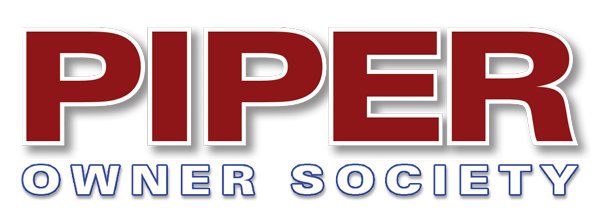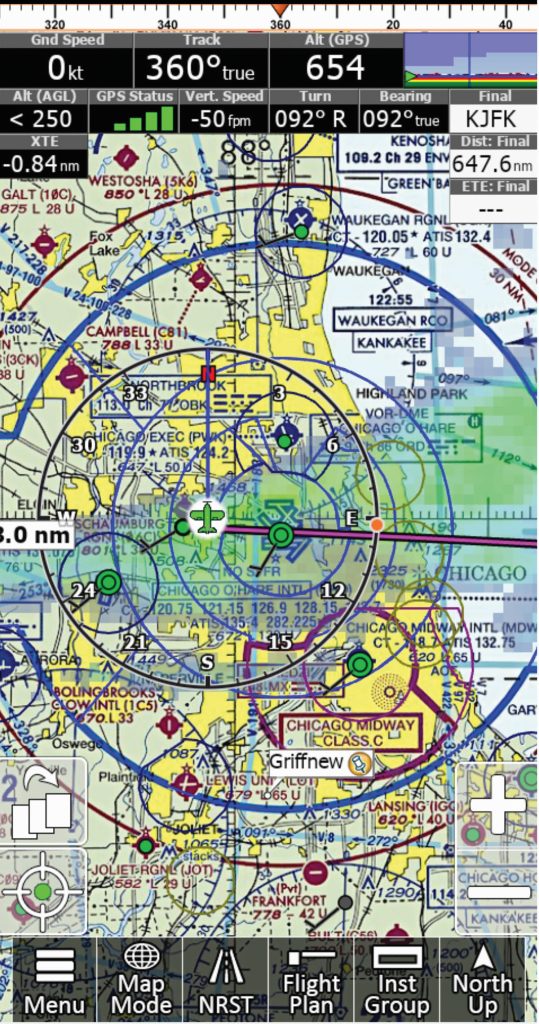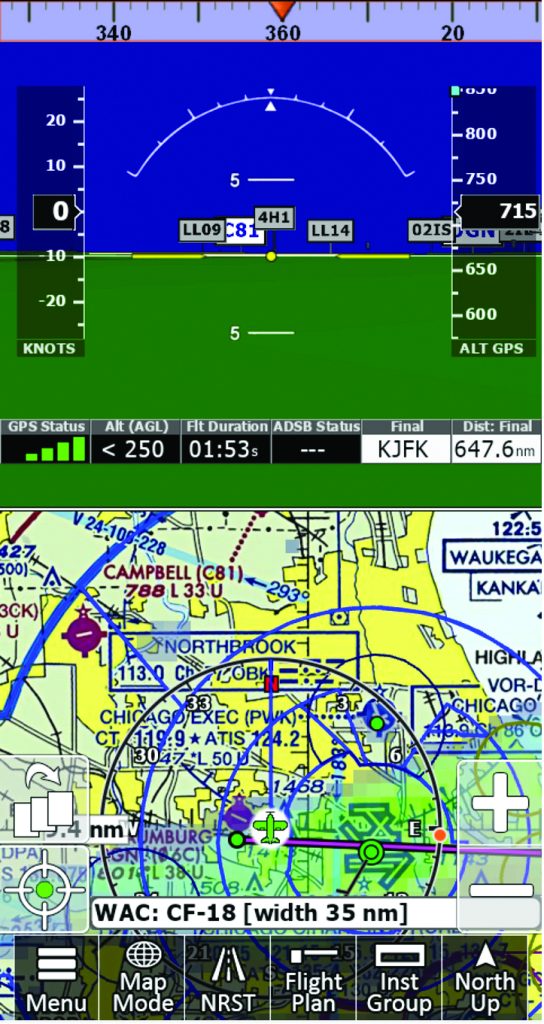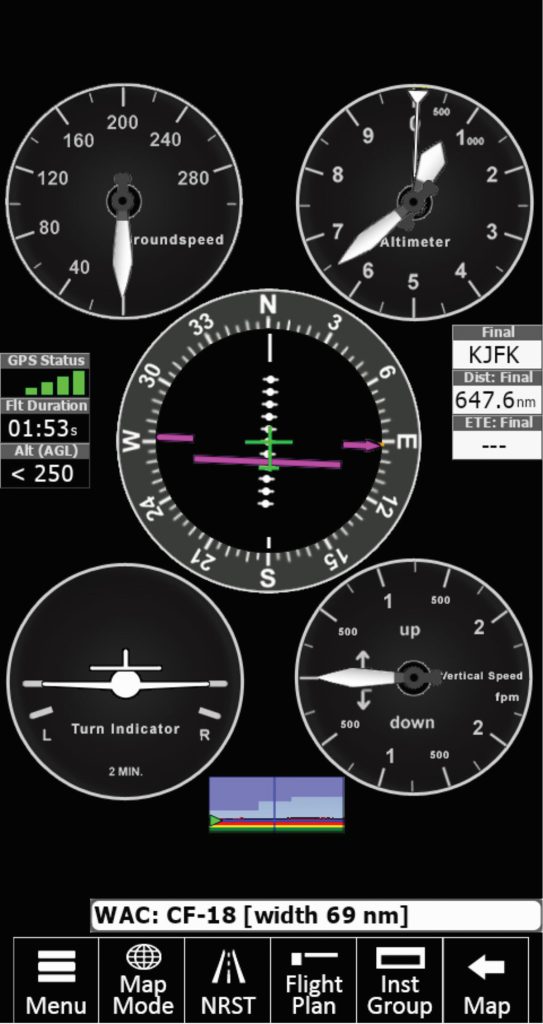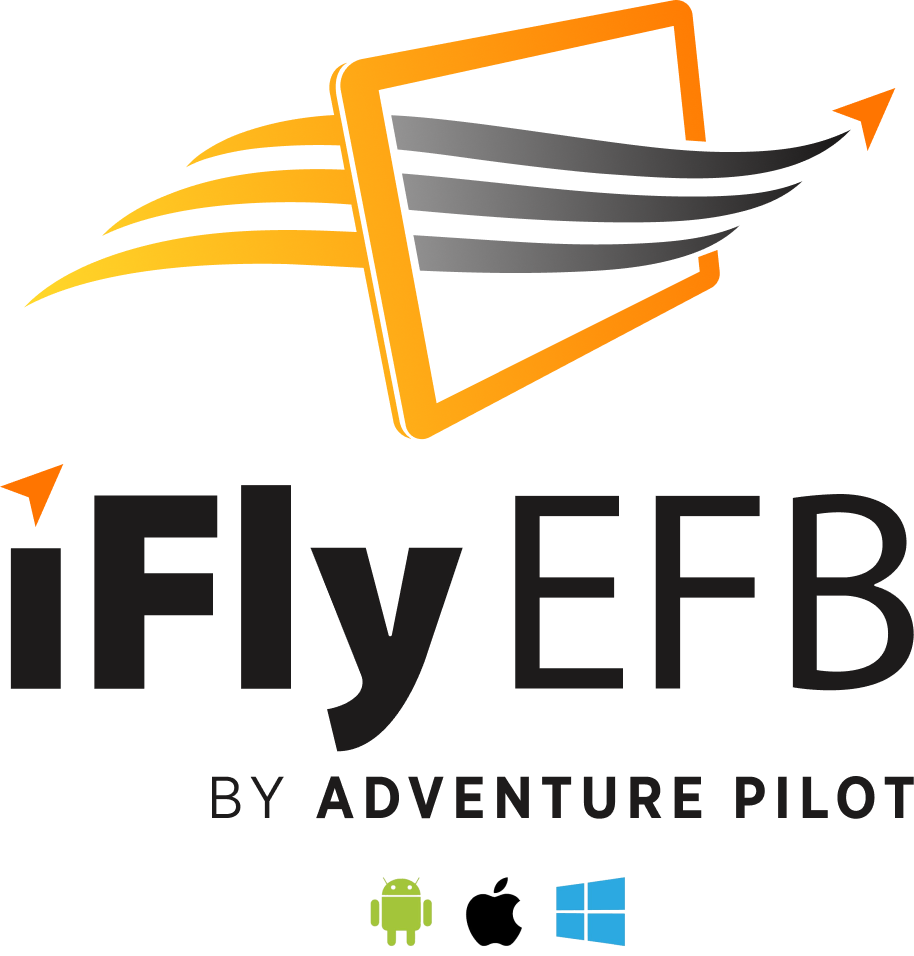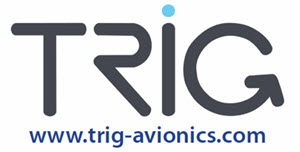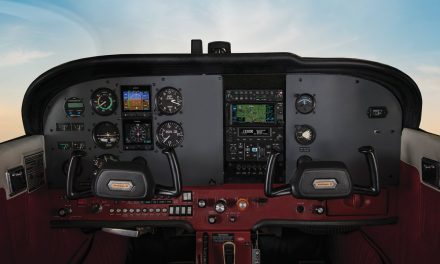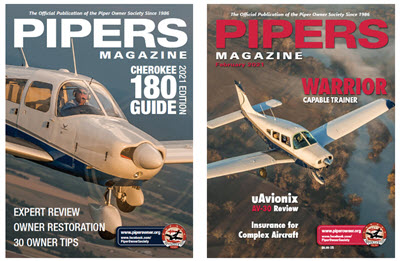By Jim Griffin
EFB Apps
I may have been one of the last people in the USA to switch from paper-based charts to an EFB (electronic flight bag) application. About 11 years ago, I received an Android tablet as a gift and downloaded a couple of freeware EFB’s. They had their faults, but I was willing to overlook them because of the price. However, the first time I used an EFB, I said to myself, “This is too easy, it’s cheating!” Since that moment, my only regret is not adopting the technology sooner.
iFly EFB Application
About 8 years ago, I was at Oshkosh looking for an EFB to replace the freeware version. I looked at a number of other EFB’s (that have since gone out of business), and of course ForeFlight. Unfortunately, ForeFlight only runs on Apple products. iPads are fantastic devices, but I already owned an Android tablet and phone. I couldn’t justify having to purchase all new hardware just to run an application that I only used while flying. Then I found iFly EFB (back then known as iFly GPS). The iFly EFB app runs on iPad’s, Androids, or Windows tablets, and you can switch seamlessly between them. I downloaded the iFly EFB application and ran it. There is a free 30-day trial period, but I didn’t need it. As soon as I ran the application, I knew I had found a winner. I was amazed at how smoothly it ran, how intuitive the interface was, and how many features were available at the touch of a finger.
Any good EFB will provide you with an incredible amount of data at your fingertip. The difference between the iFly EFB app and others is that nearly everything is available only one menu level away. A real-time, moving map provides positional awareness with GPS accuracy. VFR charts are included in the basic yearly subscription and IFR charts can be included for a modest upgrade. The IFR approach plates are georeferenced, so your positional awareness is accurate, even when you’re in the soup or in a holding pattern.
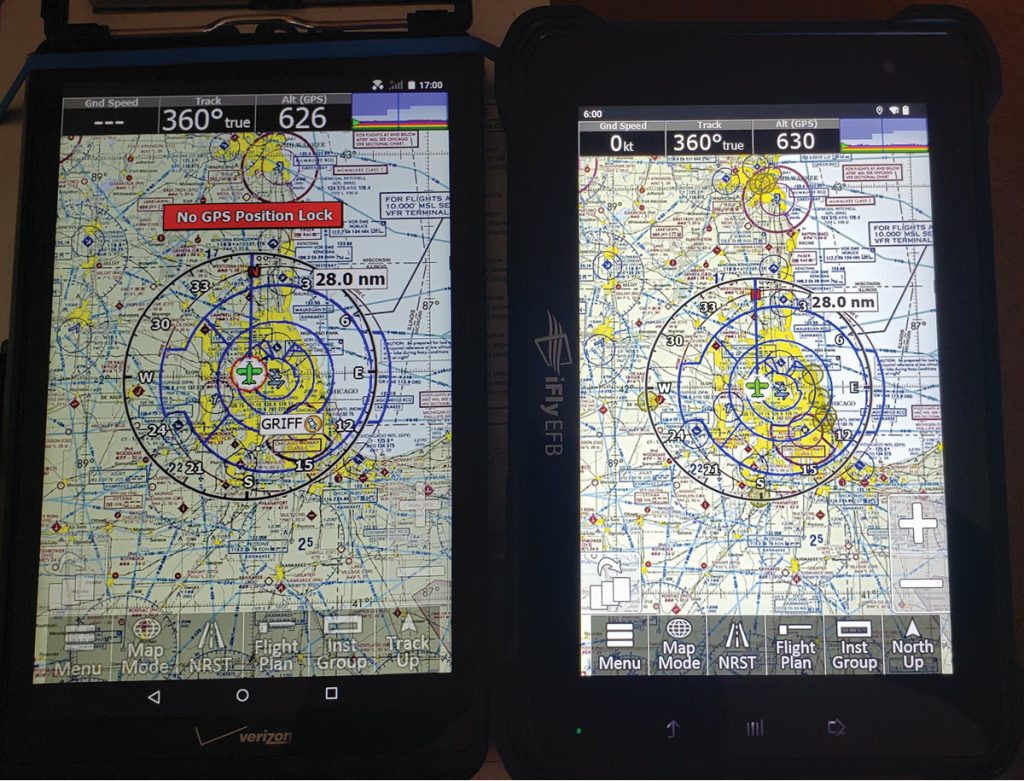
All the functions that you’d expect are included, such as:
- Moving map navigation
- Obstacles and terrain
- Flight planning
- Weight and balance
- Customizable checklists
- Runway layouts and traffic patterns
- Favored runway per current wind direction
- Frequencies (CTAF, Tower, Ground, Clearance delivery, ATC, AWOS/ATIS, etc.)
- Flight plan filing (through Leidos)
- Fuel prices
- Instruments (customizable) and gauge cluster
- Altitude planning – calculates the best altitudes across your entire flight plan to optimize your speed based on wind conditions
Connect your tablet via wireless to your ADS-B, and the device will display:
- NEXRAD weather imagery (ADS-B weather)
- ADS-B traffic
- Graphical TFR’s
- AIRMETs and SIGMETs
- 3D EFIS (highway in the sky)
- Airspace alerts
- Synthetic vision
- Updated weather at your destination
- Satellite images of airports
- Everything we used to look up in the paper AFD
The app is simply the best I’ve ever used.
New Hardware
Last year at OSH, I looked at iFly EFB’s latest hardware offering. You can purchase a tablet directly from them instead of having to do your own product testing to compare different vendors. My very trusty Android tablet has served me well for years. Being an IT professional, I keep my tablet updated to run at peak performance, but as good as my tablet is, the unit from iFly EFB outperforms it in every aspect. The first thing I noticed is that the iFly EFB tablet is heavy-duty. The second was how fast and smoothly it responds.
Here are the specs on the tablet, for those who want to know the internals:
| SYSTEM | CPU: Qualcomm Cortex-A53 64-bit Quad-Core Process 2.0 GHz |
| OS: Android 12 | |
| GPU: Adreno TM 702 | |
| RAM: LPDDR4 4GB | |
| DISPLAY | LCD: 7-inch IPS Panel, 1280 x 800, 800 nits Sunlight Readable Touch Screen |
| COMMUNICATION | WIFI: 2.4GHz & 5GHz |
| Bluetooth: 2.1 EDR/3.0 HS/4.2 LE/5.0 LE | |
| INTERFACE | Type-C (cannot be used simultaneously with USB Type-A on the device) |
| Micro SD Slot: 1 x Micro SD card, Supports up to 512GB | |
| Ear Jack: Standard 3.5mm earphone connector | |
| Docking Connector: POGO PIN x24 | |
| POWER SUPPLY | Power: DC 8-36V |
| Battery: 3.7V, 5000mAh battery (5 Hours) | |
| FORM | Size: 8.125″ x 5.375″ x 1″ |
| Weight: 1 lb 12 oz |
I wanted to test the iFly EFB tablet side by side with my trusty tablet. I charged up both to 100% and turned up the brightness on both to maximum. I brought them outside for a sunlight comparison, and there is a marked difference. In the pictures, you can see that there is an even more distinct difference in the brightness and readability of the screens in lower light situations.
Battery
Next it was time to test the batteries. I left both devices at 100% brightness, and kept the app running, which does not allow the devices to go into sleep mode. After three and a half hours, the remaining charge on both tablets was down to around 26 to 27%, and both were within 1% of each other. Normally I would call that a draw, however, it is important to note that the iFly EFB unit was substantially brighter the entire time. In the real world, this means you can utilize a lower brightness setting, and your batteries will last longer. When it’s time to recharge the batteries, the iFly EFB tablet has a built-in USB Type-C port and an A/C adapter port.
Speaking of charging, if you go on long cross-country flights, my personal recommendation is to use a 2-amp USB charger no matter what type of tablet you own. I have a dual port USB charger plugged into the cigarette lighter in my plane. When my tablet is connected to the 1-amp receptacle, it will slowly lose power during long flights, but the 2-amp charger keeps it topped off nicely. A 2-amp power source will ensure your device and you remain happy while you and your loved ones cruise to your destination.
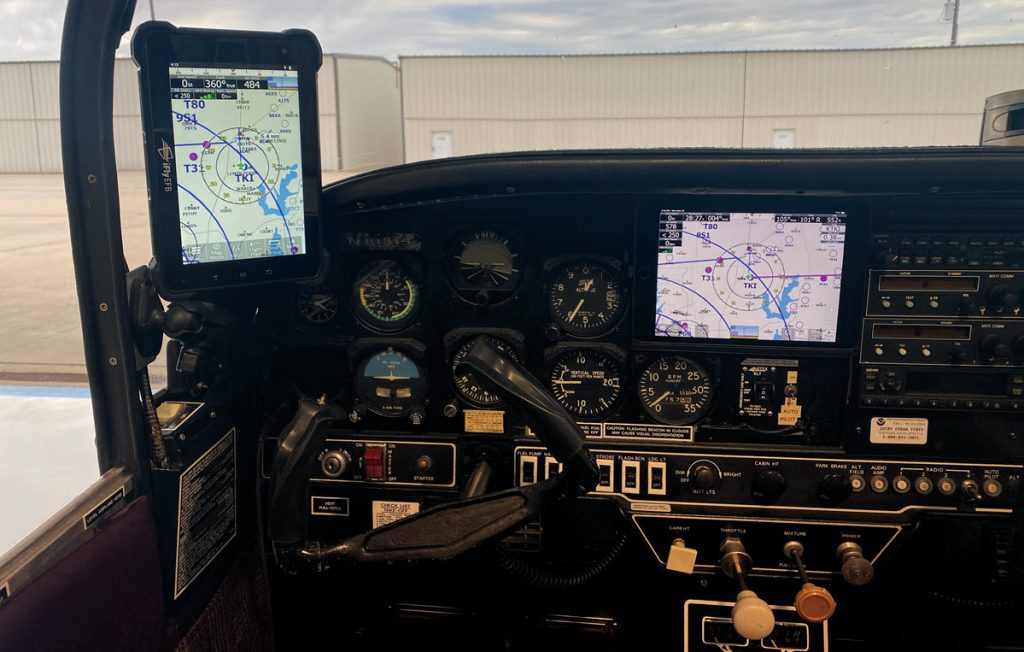
Mounting
There are many mounting options as the tablet will work with a RAM mount, or a docking station.
Software and App Updating
The software and database updater for the iFly EFB app is bulletproof. No need to log in to the website or run a database manager, and you don’t need special USB cables or memory cards.
All you need is a Wi-Fi Internet connection. Open the app and it will tell you if your charts are expired or click on the “Check for Updates” button, it’s literally that simple.
You can choose what you would like updated. When you confirm, all expired charts, plates, databases, and application software are updated automatically. The amount of data is usually large, and the app even warns you to connect to Wi-Fi so you don’t consume your cellular data plan. The process is so seamless that you can even continue using the app while updates are in progress.
NMEA Port
The iFly EFB tablet comes with an NMEA (National Marine Electronics Association) port. It is an interface to electronic marine devices like GPS and ship autopilots through the docking station. My opinion is that it’s only a matter of time until someone develops an interface to an airplane device like an autopilot. If you are a boater or mariner, load your marine app on the tablet, and interface your NMEA capable equipment with the tablet immediately.
Trade-ins
If you already own one of the iFly EFB 740B devices, call and speak with them about their trade-in plan. The phone number and website are listed at the bottom of this article.
ADS-B Connectivity
The iFly EFB app will connect with 99% of the ADS-B systems out there, with the exception of one. Garmin’s ADS-B wireless connection protocol is proprietary. As a result, iFly EFB cannot connect to Garmin ADS-B’s, and neither can 99% of the other apps out there. On the upside, I counted no less than 16 different ADS-B’s the app will connect to. All the major brands are included.
Current pricing is $94.99 per year and allows you to run the app on 2 devices. Add $55 per year for IFR. An additional $29.99 per year will allow you to share your subscription across 4 iPads/ iPhones, Android phones and tablets, Windows devices and iFly Aviation Portables.
